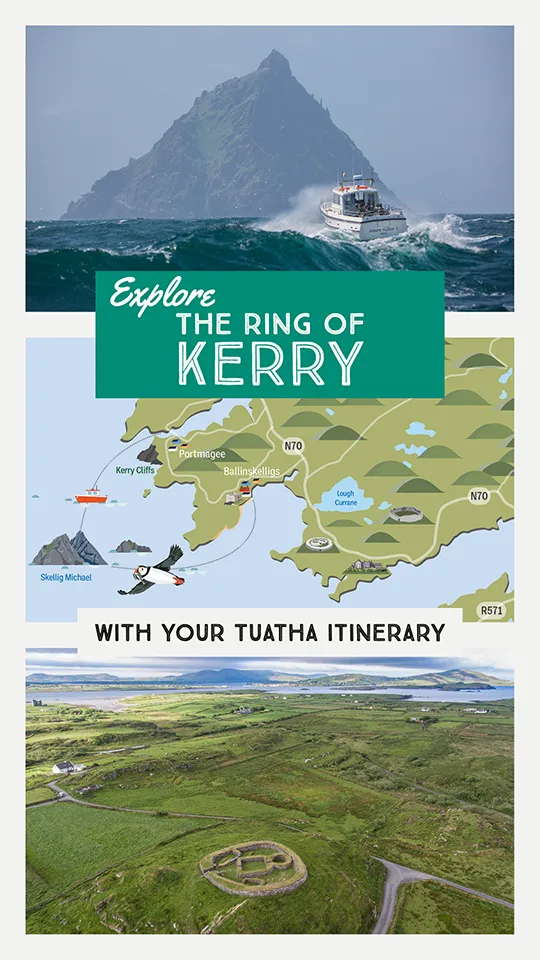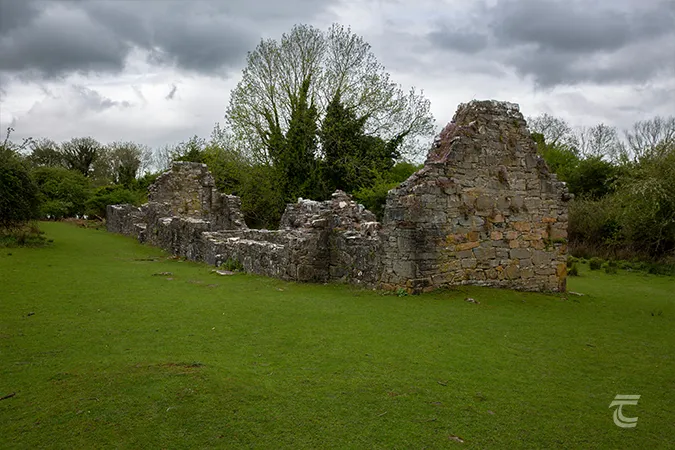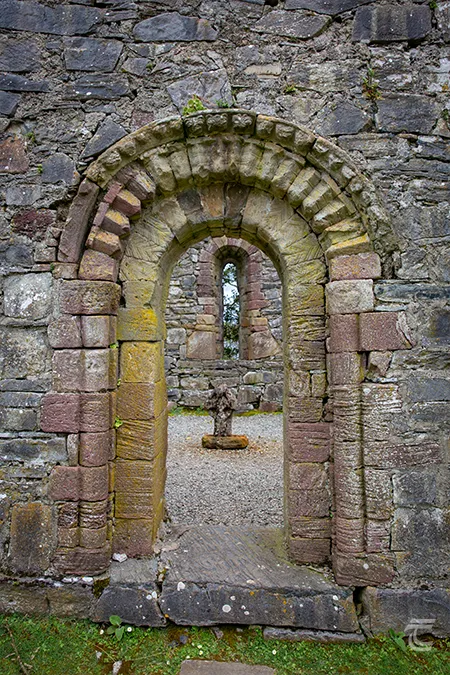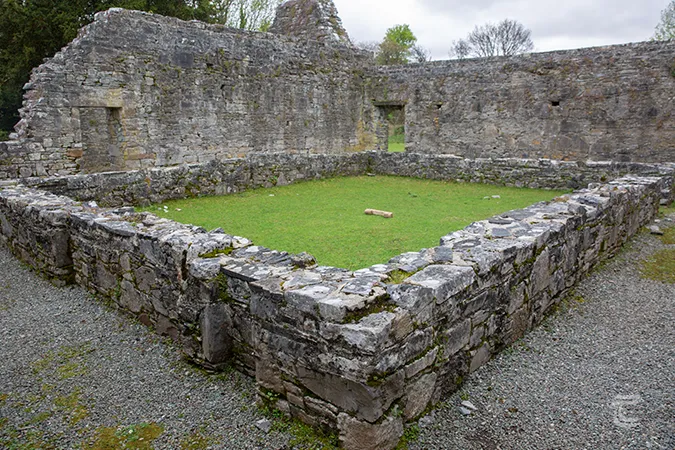Innisfallen Island
The name Inisfallen Island derives from the Irish Inis Faithlinn, meaning ‘Faithlinn’s Island’. The foundation of the first monastery here is credited to St Finian, who is said to have brought a community of monks to pray in the peaceful and beautiful setting of Lough Leane. The island is large enough to have allowed the monks to have remained relatively self-sufficient, with room enough to plant crops, tend a small amount of livestock, harvest timber, and fish the lake.
As discussed by Padraig Ó Riain in the excellent Iveragh Peninsula: A Cultural Atlas of the Ring of Kerry, St Fíonán can be a little confusing given the interchangeable stories relating to a number of similarly named saints and early religious figures, including Fíonán, Finan, Finian, Fionnán, Fíonán Cam of Kinnity in Offaly, Fíonán of Corca Dhuibhne, and Fíonán the Leper. To add to the confusion, at least some of those listed may be the same individual. Of these, it is Fíonán the Leper who is most usually credited with the first foundation on Innisfallen Island. According to the Martyrology of Tallaght, St Fíonán the Leper is associated with Swords in Dublin and Clonmore in County Wexford, with his feast day celebrated on the 16th March. The earliest record of the feast being celebrated in Kerry on that day comes from c.1170, when Maol Muire Ua Gormáin, a canon regular of St Augustine, located the saint on Innisfallen Island.
However, others such as Archbishop John Healy, have declared that it is more likely that Fíonán of Corca Dhuibhne was the founder of Innisfallen. Though today Corca Dhuibhne is more closely associated with the Dingle Peninsula, in the medieval period it encompassed the Iveragh Peninsula too. The biography, the Life of Fíonán, preserved in the Salamancan Codex, describes how the saint was born into a noble family in Corca Dhuibhne, and that he was sent as a child to learn from the famous St Brendan, with the two main centres of his activity being on Inisfallen Island on Lough Leane, and at Lough Currane near Waterville in County Kerry.
For practical information about visiting this site Click Here
The name Inisfallen Island derives from the Irish Inis Faithlinn, meaning ‘Faithlinn’s Island’. The foundation of the first monastery here is credited to St Finian, who is said to have brought a community of monks to pray in the peaceful and beautiful setting of Lough Leane. The island is large enough to have allowed the monks to have remained relatively self-sufficient, with room enough to plant crops, tend a small amount of livestock, harvest timber, and fish the lake.
As discussed by Padraig Ó Riain in the excellent Iveragh Peninsula: A Cultural Atlas of the Ring of Kerry, St Fíonán can be a little confusing given the interchangeable stories relating to a number of similarly named saints and early religious figures, including Fíonán, Finan, Finian, Fionnán, Fíonán Cam of Kinnity in Offaly, Fíonán of Corca Dhuibhne, and Fíonán the Leper. To add to the confusion, at least some of those listed may be the same individual. Of these, it is Fíonán the Leper who is most usually credited with the first foundation on Innisfallen Island. According to the Martyrology of Tallaght, St Fíonán the Leper is associated with Swords in Dublin and Clonmore in County Wexford, with his feast day celebrated on the 16th March. The earliest record of the feast being celebrated in Kerry on that day comes from c.1170, when Maol Muire Ua Gormáin, a canon regular of St Augustine, located the saint on Innisfallen Island.
However, others such as Archbishop John Healy, have declared that it is more likely that Fíonán of Corca Dhuibhne was the founder of Innisfallen. Though today Corca Dhuibhne is more closely associated with the Dingle Peninsula, in the medieval period it encompassed the Iveragh Peninsula too. The biography, the Life of Fíonán, preserved in the Salamancan Codex, describes how the saint was born into a noble family in Corca Dhuibhne, and that he was sent as a child to learn from the famous St Brendan, with the two main centres of his activity being on Inisfallen Island on Lough Leane, and at Lough Currane near Waterville in County Kerry.
For practical information about visiting this site Click Here
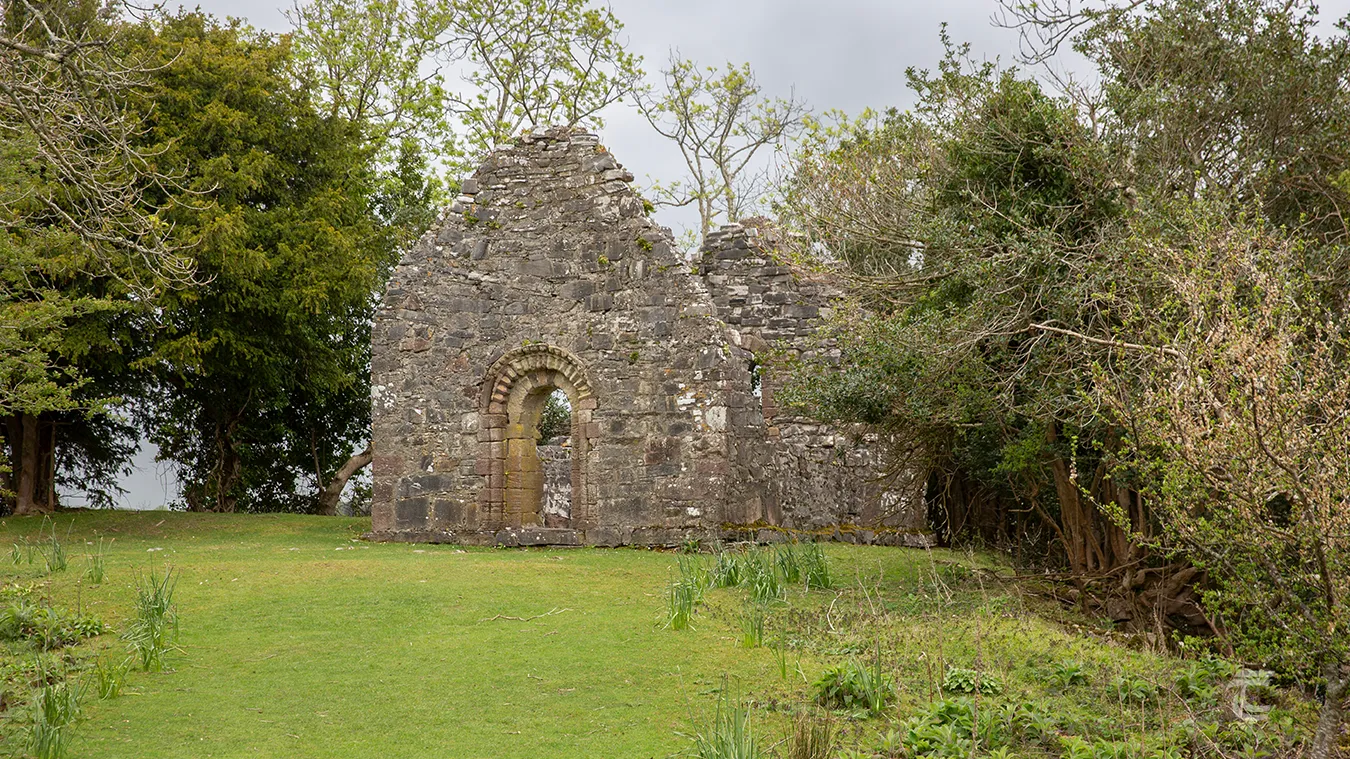
The Hiberno-Romanesque oratory • Innisfallen Island
Despite being a monastic settlement, Innisfallen Island was not always a place of seclusion and peaceful retreat. It is recorded that the island was raided on a number of occasions by the Vikings, and later, by the O’Donoghue’s in the 12th century. The Annals of Innisfallen described that attack in 1180:
‘Innisfallen was plundered by Mal Duin, son of Donal O’Donoghue, and much gold and silver was taken out of the church.’
By the end of the 12th century, Innisfallen Island was under the auspices of the Augustinian Canons who established the Priory of St Mary on the island, constructing it around the site of the early monastery.
Innisfallen Island became renowned as a place for learning and it was here that the famous Annals of Innisfallen were compiled. The Annals of Innisfallen were reputedly started elsewhere in Munster, possibly Emly in Tipperary, but they were maintained from at least the early 13th century to the 15th century here in the Augustinian monastery on Innisfallen Island. No manuscript copy of the Annals of Innisfallen remains in Ireland, but there is a partial copy in vellum in the Bodleian Library at Oxford. The Annals contain more than 2,500 entries spanning the years between AD 433 and 1450. As well as the chronological entries, it also has a fragmented account of the history of pre-Christian Ireland – known as the pre-Patrician section – from the time of Abraham to the arrival of Saint Patrick in Ireland.
Innisfallen Abbey
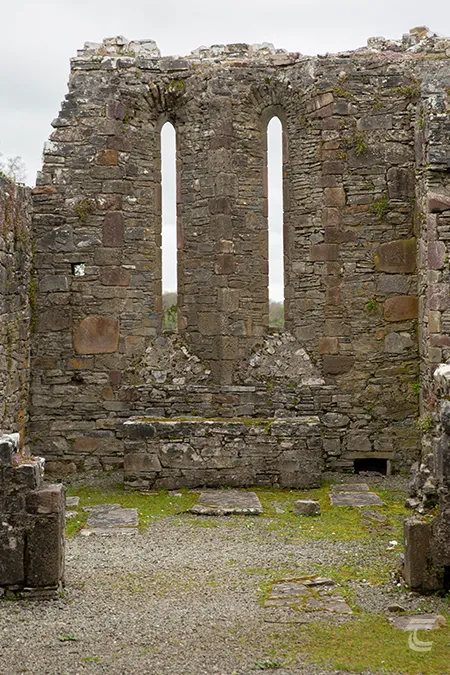
The two-light window in the church • Innisfallen Island
There is little substantial remains to be seen of the earliest phases of the monastery today, though there are faint traces and tantalising hints of earlier buildings that can still be discovered. The Augustinian abbey is laid out a little unusually in that the cloister and domestic buildings are situated north of the church, instead of to the more typical south. However this is not entirely unique, as the famous St Augustine’s Abbey in Canterbury is also laid out with the church to the south. Perhaps it was that which inspired this smaller abbey on Innisfallen Island.
The priory church appears to incorporate an earlier church that dates to around the 10th – 11th century, as the western end of the nave has a different masonry style with antae, a typically pre-Romanesque architectural style of Irish churches. There is a bullaun stone near the western gable and some of the graveslabs may be of an early medieval date. There is also clear evidence of reused stones, suggesting that the earlier monastic buildings were largely recycled into the Augustinian priory. However, this is a little muddied by later conservation efforts, so it can be difficult to pick out 13th century reconstruction with 19th and 20th century interventions. The piscina in the church has some Romanesque style to it, though the lintel is a concrete addition that was inserted during the conservation works. The church also has a fine sandstone two-light window.
Just next door is the 12th century Romanesque ‘Abbot’s Church’. This is divided into a nave and chancel by a largely reconstructed Romanesque cloister arch, that survives to a relatively low level. Near the top of the northern part of the arch you can see a wonderful Hiberno-Romanesque carving of a face. It is traditionally believed to represent St Finian.
The cloister garth is set to the north of the churches, though it was reconstructed during the conservation works to a lower wall level. The arches and any sort of covered walkway no longer exists. The cloister gave access to two additional ranges of buildings, one to the east and one to the north. The eastern range features a long rectangular building, divided into two rooms by a partition wall. Though looking carefully at the architecture it appears that there has been modifications and alterations through time, and that it may have originally been three rooms. There is also evidence that it had an upper floor that no longer exists. Typically the eastern range of an Augustinian Priory served as an administrative centre for the abbey. This is where you could expect to find the Prior’s Room and a Sacristy. Though there may have been a dormitory on the upper level.

The two-light window in the church • Innisfallen Island
The northern range probably served as the refectory, with some evidence of a reader’s pulpit where a monk would read the Scriptures as the rest ate in silence. The buildings to the north of the main abbey complex were likely ancillary structures like the kitchens, where you can still see an oven. The buildings to the north-west likely served more administrative functions with accommodation.
A beautiful, if small, Hiberno-Romanesque oratory is located just to the north-east of the main complex of the Augustinian Abbey. It is a single-celled structure, made largely of limestone and set on a notable plinth that almost overhangs the steep slope to the east. It has a sandstone window in the eastern gable, and a doorway, both made of red and yellow sandstone, in the ornate Hiberno-Romanesque style. Unfortunately, the doorway is quite weathered so it is difficult to make out some of the once ornate decoration. What can be seen appears to be more similar to that on the Nun’s Church at Clonmacnoise, County Offaly, than the closer example at Kilmalkedar on the Dingle Peninsula. There is also a small ringed-cross inside the church, that was found in the lake.
The Later History of Innisfallen Abbey and the Legend of Innisfallen Island
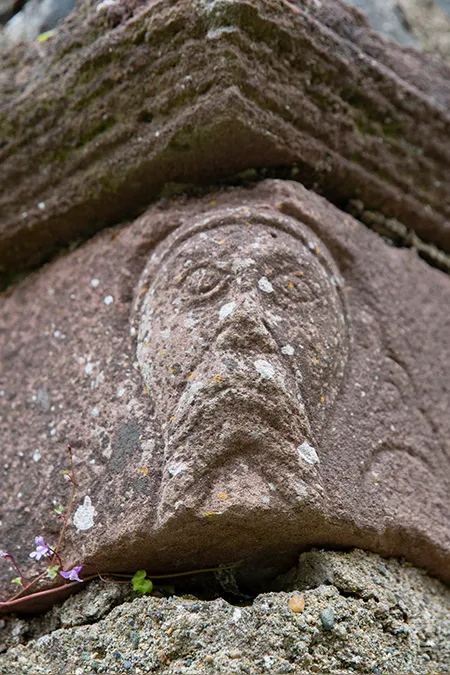
A Hiberno-Romanesque face, a representation of St Fíonán? • Innisfallen Island

A Hiberno-Romanesque face, a representation of St Fíonán? • Innisfallen Island
In 1582 the island was granted to Sir Richard Collum, but by the end of the 16th century it was in the ownership of Sir Valentine Browne, Earl of Kenmare. Subsequent earls developed the island as a tourist attraction throughout the late 17th/early 18th century. By 1840 visits to the island declined and by the beginning of the 20th century Innisfallen was in the ownership of the McShain family. In 1973, the McShain family passed Innisfallen, and most of the Muckross Estate, into State ownership. Both are now part of Killarney National Park.
A strange story is recorded by T. Crofton Croker in Legends of Kerry (1972). It describes how a member of the monastic community on Innisfallen, Father Cuddy, set out on a boat one morning to collect wine from Muckross Friary. He was warmly welcomed, and promises were made that wine would be sent back to Innisfallen. However, on his return journey, Father Cuddy heard an unfamiliar bird signing a beautiful song. As he listened, the song grew louder, and Father Cuddy knew the music was not of this world, causing him to fall to his knees and pray. When the music stopped, Father Cuddy looked around in astonishment at a place all at once familiar and changed. The mountains were still majestic, the lake waters still rippled with reflected light, but wild forest grew where once fields were tended, and roads were swallowed by woodland. The weather was cold and wintry, in contrast to the bright summer’s day that began his journey. He stood, and noticed that his knees had left imprints in the stone. Baffled, he set off for Innisfallen Island as quickly as he could, to report these eerie and unearthly events. When he arrived, instead of the monkish porter he met a man dressed in strange clothes. Father Cuddy asked had the wine arrived, but the man looked confused, and asked him his business. Father Cuddy told the man that he set out the day before to order wine for the monastery. The man was astonished, and told Father Cuddy that the monastery was long gone, its community scattered and the lands granted to Robert Collan by Queen Elizabeth of England. The man told Father Cuddy that he had heard a story of a monk who had set out to collect wine but who had never returned. It was thought he must have drowned in the lake, but that this had all occurred some 200 years ago. He warned the shocked Father Cuddy that priests and monks were no longer welcome in Ireland, and that he should flee. Father Cuddy realised that he had fallen under a miracle or enchantment of some sort, and grieved for his friends and community that he left, now unreachable across time. He travelled to Dingle to take ship to Spain, where he quietly lived out the rest of his days in a monastery in Malaga.
Innisfallen Island is one of 24 islands on Lough Leane. Another of these, Ross Island, lies just to the south-east, and is connected to the mainland via a small bridge. The island is significant as it provides some of Ireland’s earliest evidence of copper mining. Unfortunately most of the remains have been destroyed by later mining so there is little to see today. A recent archaeological excavation of a small cave on Ross Island uncovered stone hammers and flint tools, believed to date to the earlier part of the Bronze Age. If you are lucky on the boat journey, you may also see a white-tailed sea eagle that nests on the shoreline.
Though there are many other places of interest nearby, there is something special about Innisfallen Island. The island was described by the 19th century antiquarian Samuel Lewis as: ‘the most beautiful and interesting of all in the Lower Lake; it is extremely fertile and richly clothed with wood to the water’s edge…’ And it would be hard to disagree with that assessment!
Upper left: the churches of Innisfallen Abbey • Lower left: the cloisters • Right: the Hiberno-Romanesque doorway of the oratory
Top: the churches of Innisfallen Abbey • Middle: the Hiberno-Romanesque doorway of the oratory • Bottom: the cloisters
